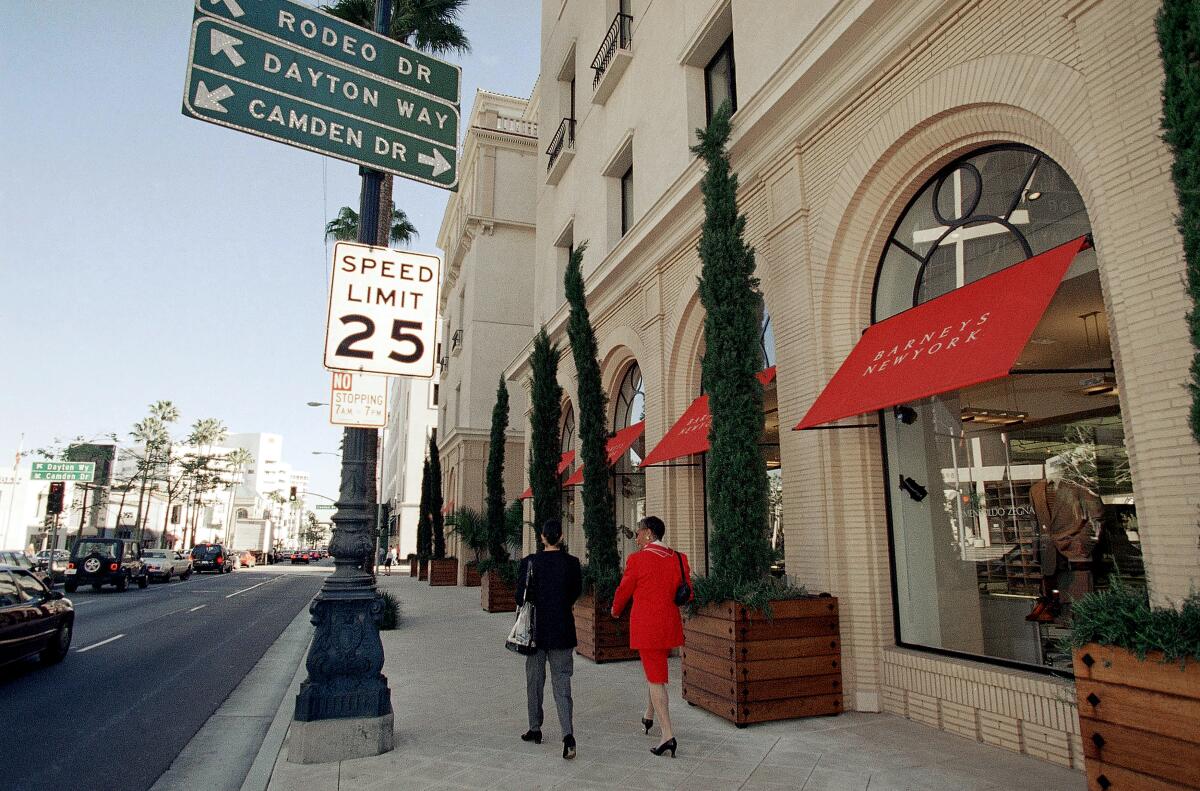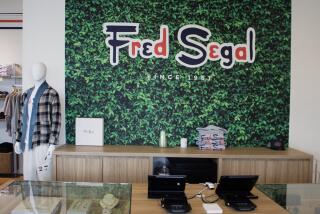Commentary: Barneys bankruptcy proves luxury retailers aren’t immune to industry turmoil

The slew of value- and mid-price retailers that have entered bankruptcy in recent years is getting some posh company.
Barneys New York, the upscale department store chain, said Tuesday that it had filed for Chapter 11 bankruptcy protection after reports that it was seeking a lifeline as it grappled with high rents and tough competition. The retailer said it planned to close 15 physical stores. The remaining business will include five flagship department stores, including the one in Beverly Hills; two Warehouse stores; and its e-commerce shop.
Barneys isn’t a particularly large chain: Saks Fifth Avenue and Neiman Marcus are close competitors that have more stores. So its closings won’t roil the retail landscape like those of ubiquitous retailers such as Sears or Toys R Us. However, thanks to paparazzi photos of Kim Kardashian and other celebrities stopping by its stores, as well as the reputation of its Freds restaurant as a hub for New York’s elite, Barneys looms large as a defining emblem of American luxury.
Its financial woes are similarly symbolic because they demonstrate just how much the pressure to innovate in the luxury business has ramped up in recent years.
Luxury apparel and accessory brands and stores weren’t exactly at the leading edge of e-commerce, with some in the industry believing that shoppers would never migrate en masse to the internet when looking for expensive pieces that were traditionally sold with high-touch customer service. That notion has been disproved, and online is quickly becoming the category’s most important battleground.
It isn’t that Barneys stood still on e-commerce. I remember interviewing a senior e-commerce executive there in 2015 and thinking the company was making good progress on buzzy industry ideas such as personalization. The problem is that competition for a relatively narrow market — meaning shoppers who can shell out $4,820 for a midi dress — is becoming fiercer.
Richemont’s Net-a-Porter has established itself as a go-to digital destination. Matches Fashion, which is based in the U.K. but counts the United States as its largest market, is becoming a formidable e-commerce force with a particular emphasis on introducing customers to new, under-the-radar designers. That is something Barneys has also been known for over the years.
Meanwhile, marquee luxury brands are lavishing more attention on their own stores and websites, seeking more control over the customer experience. And resale marketplaces such as Farfetch Ltd. and the RealReal Inc. are putting secondhand luxury inventory at shoppers’ fingertips. In other words, customers who might have defaulted to Barneys five years ago have seen an explosion of other options.
Barneys isn’t just a victim of evolving shopping habits, though. The company said it has also been choked by high rents. The Wall Street Journal has reported the rent on its Madison Avenue store has risen to $27.9 million from $16.2 million earlier this year. According to data from CBRE, rents in prime shopping areas in Manhattan have fallen from recent peaks but remain elevated from where they were at the beginning of the decade.
It’s clear that the value of big-city flagships is being reevaluated up and down the retail food chain. Lord & Taylor closed its storied Manhattan location, and Ralph Lauren Corp. and Abercrombie & Fitch Co. have also moved to give up New York flagships. These chains seem to be deciding that they don’t need flashy showpieces, just productive stores.
The trouble is, an ultra-high-end retailer like Barneys does need showpieces. It needs its stores to be emporiums of rarity and inspiration. Matches Fashion recently set up a temporary shop on a yacht and ferried customers around the Italian coastline. The renovated Selfridges in London is setting an extremely high bar for what global luxury shopping should look like. Barneys needs to keep up, and having sprawling, well-appointed stores in big cities is part of that.
So, while less-upscale retailers can afford to ditch or shrink their lavish flagships, Barneys simply can’t. And that makes its recovery that much more difficult.
Barneys may emerge from its bankruptcy as a smaller but healthier company. The fact that it ended up here, though, should put the rest of the luxury world on notice. No matter how iconic your brand, you aren’t immune to sweeping change.
More to Read
Inside the business of entertainment
The Wide Shot brings you news, analysis and insights on everything from streaming wars to production — and what it all means for the future.
You may occasionally receive promotional content from the Los Angeles Times.










